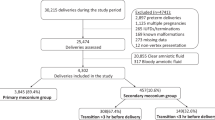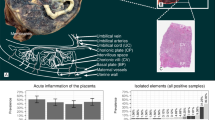Abstract
OBJECTIVE: As the volume of fetal surgery cases has steadily increased, an increasing incidence of chorioamniotic membrane separation (CMS) has been noted. Due to the potential adverse consequences from this abnormality, we reviewed the last decade of experience with fetal intervention at our institution and examined the incidence and outcomes of fetuses given this diagnosis.
STUDY DESIGN: A retrospective chart review of 75 fetal surgery cases at our institution was performed. Variables analyzed included preoperative, operative, and outcome data. Postoperative ultrasounds were evaluated for the presence of CMS.
RESULTS: Excluding operative deaths, the incidence of CMS was 47%. There were significant differences (p<0.05) in time to delivery (7 vs 5 weeks), cases using a perfusion pump (80% vs 60%), and number of trocars (2.13 vs 1.54) in cases of CMS versus those without. Ultrasounds showed normal to high levels of amniotic fluid in 97% of cases. There was an increased incidence of premature rupture of membranes (63% vs 45%), preterm labor (57% vs 38%), and chorioamnionitis (29% vs 15%) with CMS, but no difference in mortality rate.
CONCLUSION: CMS is a frequent finding following fetal surgery. It is associated with significant morbidity but is manageable with close follow-up in a hospital setting. Following fetal surgery, the finding of CMS can be a life-threatening complication that warrants further study to understand its etiology and prevention.
This is a preview of subscription content, access via your institution
Access options
Subscribe to this journal
Receive 12 print issues and online access
$259.00 per year
only $21.58 per issue
Buy this article
- Purchase on Springer Link
- Instant access to full article PDF
Prices may be subject to local taxes which are calculated during checkout

Similar content being viewed by others
References
Graf JL, Bealer JF, Gibbs DL, Adzick NS, Harrison MR . Chorioamniotic membrane separation: a potentially lethal finding Fetal Diagn Ther 1997; 12: 81–4
Levine D, Callen PW, Pender SG et al. Chorioamniotic separation after second-trimester genetic amniocentesis: importance and frequency Radiology 1998; 209: 175–81
Borlum KG . Second trimester chorioamniotic separation and amniocentesis Eur J Obstet Gynecol Reprod Biol 1989; 30: 35–8
Burrows PE, Lyons EA, Phillips HJ, Oates I . Intrauterine membranes: sonographic findings and clinical significance J Clin Ultrasound 1982; 10: 1–8
Kaufman AJ, Fleischer AC, Thieme GA, Shah DM, James AE . Separated chorioamnion and elevated chorion: sonographic features and clinical significance J Ultrasound Med 1985; 4: 119–25
Heifetz SA . Strangulation of the umbilical cord by amniotic bands Pediatr Pathol 1984; 2: 285–304
Bourne G . The microscopic anatomy of the human amnion and chorion Am J Obstet Gynecol 1960; 79: 1070–3
Albanese CT, Harrison MR . Surgical treatment for fetal disease. The state of the art Ann NY Acad Sci 1998; 847: 74–85
Author information
Authors and Affiliations
Rights and permissions
About this article
Cite this article
Sydorak, R., Hirose, S., Sandberg, P. et al. Chorioamniotic Membrane Separation Following Fetal Surgery. J Perinatol 22, 407–410 (2002). https://doi.org/10.1038/sj.jp.7210753
Published:
Issue Date:
DOI: https://doi.org/10.1038/sj.jp.7210753
This article is cited by
-
Complete chorioamniotic membrane separation with constrictive amniotic band sequence and partial extra-amniotic pregnancy: serial ultrasound documentation and successful fetoscopic intervention
Journal of Perinatology (2014)
-
Current status of fetal surgery
The Indian Journal of Pediatrics (2005)



